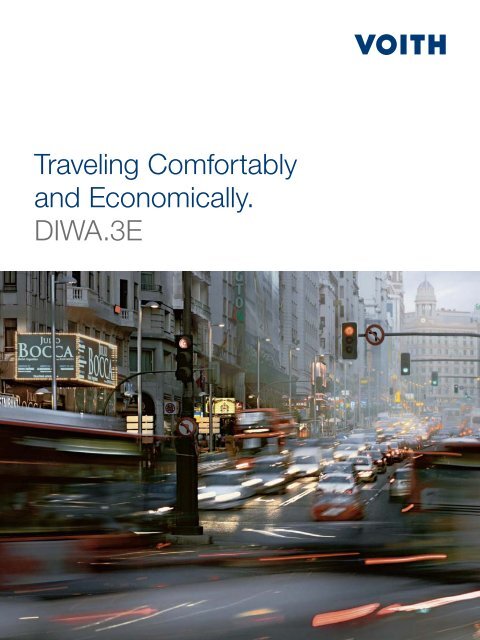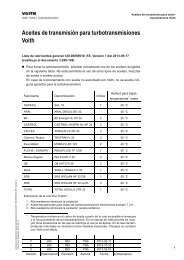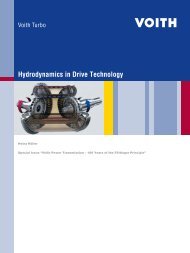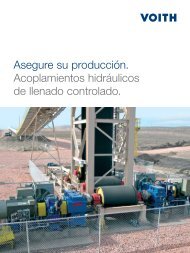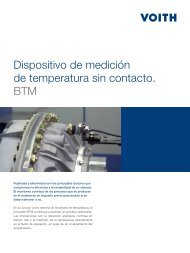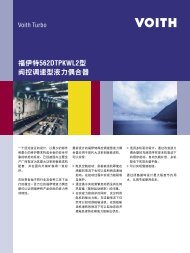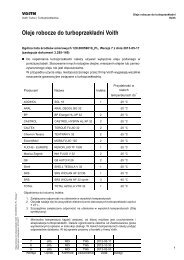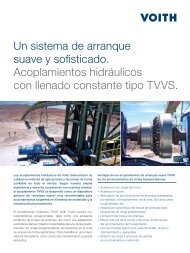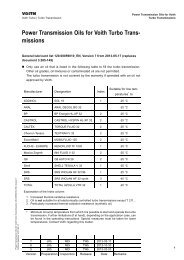Traveling Comfortably and Economically. DIWA.3E - Voith Turbo
Traveling Comfortably and Economically. DIWA.3E - Voith Turbo
Traveling Comfortably and Economically. DIWA.3E - Voith Turbo
You also want an ePaper? Increase the reach of your titles
YUMPU automatically turns print PDFs into web optimized ePapers that Google loves.
<strong>Traveling</strong> <strong>Comfortably</strong><br />
<strong>and</strong> <strong>Economically</strong>.<br />
<strong>DIWA.3E</strong><br />
1
DIWA-Transmissions – Economy <strong>and</strong><br />
Comfort Through Convincing Technology.<br />
Today, virtually all midi, city <strong>and</strong> long-distance buses can be fitted<br />
with <strong>Voith</strong> automatic transmissions. The unique principle of the<br />
DIWA transmission, the differential converter, is a technology<br />
suitable for the entire catalogue of modern combustion engines.<br />
The proven DIWA power-split principle<br />
allows smooth acceleration across a<br />
speed range where other transmissions<br />
need to shift gears two to three times.<br />
This makes DIWA the epitome of economical<br />
bus transmissions: up to 50 %<br />
fewer gearshifts means less wear <strong>and</strong><br />
higher driving comfort.<br />
Wear reduction <strong>and</strong> comfort become visible<br />
One gear replaces two conventional gears<br />
a<br />
Engine output<br />
0<br />
DIWA automatic transmission<br />
hydrodynamic share<br />
mechanical share<br />
Starting range<br />
a = gear shift<br />
b<br />
a<br />
b<br />
Engine output<br />
0<br />
Starting range<br />
Conventional automatic transmission<br />
hydrodynamic share<br />
mechanical share<br />
a = gear shift 1– 2<br />
b = Lock-up closure<br />
<strong>DIWA.3E</strong><br />
2
Superior Technology Demonstrates<br />
in Practical Application.<br />
DIWA transmissions are ideally<br />
adapted to the technology developments<br />
on the commercial vehicle<br />
sector. The transmissions <strong>and</strong> their<br />
gear-shifting programs comply with<br />
the environmentally friendly low-emission<br />
combustion engines <strong>and</strong> the<br />
latest emission st<strong>and</strong>ards. Their electronic-hydraulic<br />
control increases the<br />
gear-shifting quality in such a way<br />
that the gearshifts are hardly perceptible<br />
even under extreme conditions.<br />
The acceleration-dependent gear-shifting<br />
program takes the acceleration <strong>and</strong><br />
load condition of the bus into consideration<br />
<strong>and</strong> places the gear-shifting points<br />
automatically into the optimum consumption<br />
range. The unique PC diagnosis<br />
is capable of recording the functions<br />
of the transmission both during driving<br />
<strong>and</strong> at st<strong>and</strong>still of the bus. The control<br />
system also features an operating data<br />
evaluation mode. The evaluation of<br />
operating data allows a detailed analysis<br />
of traffic situations <strong>and</strong> helps when<br />
it comes to selecting a driveline that<br />
is tailor-made to its actual operating<br />
conditions.<br />
Further advantages: a filter that is integrated<br />
into the housing, a compact<br />
stainless-steel heat exchanger in modular<br />
design for a long service life <strong>and</strong> a<br />
torsional vibration damper for low<br />
engine speeds <strong>and</strong> minimum consumption.<br />
This is added by a particularly<br />
sensitive adaptation of the braking behavior<br />
of the retarder: smooth activation,<br />
strong braking performance, fast<br />
switch-on/switch-off response. This is<br />
achieved by the controlled part-drainage<br />
of the converter.<br />
Performance data <strong>DIWA.3E</strong> transmission<br />
Types D 823.3E D 851.3E D 854.3E D 863.3E D 864.3E<br />
Input power P 1max<br />
[kW] 180 220 220 290 290<br />
Input torque M 1max<br />
[Nm] 650 1 100 1 100 1600 * 1 600 *<br />
Input speed n 1max<br />
[rpm] 2 800 2 800 2 500 2 800 2 500<br />
Retarder braking torque M BR<br />
** [Nm] 2 000 2 000 2 000 2 000 2 000<br />
Number of gears *** 3 3 4 3 4<br />
Transmission mass (dry)<br />
incl. retarder [kg] 270 275 310 280 315<br />
Max. vehicle weight [t] 15 28 28 28 28<br />
Major areas of application: Midibuses St<strong>and</strong>ard single deckers <strong>and</strong><br />
articulated buses<br />
Buses with high transmission input torque also<br />
suitable for long- distance/intercity applications<br />
* For engines exceeding 1 300 Nm with torque reduction during gear-shifting<br />
** Maximum value, depending on retarder configuration<br />
*** 1 st gear with hydrodyn. / mechan. power splitting (DIWA driving range)<br />
3
Design <strong>and</strong> Operation of DIWA Transmissions.<br />
The mature design of <strong>Voith</strong> automatic<br />
transmissions is up-to-date with the<br />
latest technological developments. It<br />
is simple, logical <strong>and</strong> clear.<br />
The heart of the DIWA transmission is<br />
the hydrodynamic counter-rotating torque<br />
converter. Situated in front of it are the<br />
impeller, the 3rd gear clutch, the differential<br />
gear <strong>and</strong> the input clutch. With<br />
the 4-speed transmission, the converter<br />
is additionally preceded by the clutch<br />
for the 4th gear which is designed as<br />
overdrive. Behind the converter, an epicyclical<br />
gear combines the hydrodynamic<br />
<strong>and</strong> mechanical forces.<br />
The final set of epicyclical gears activates<br />
the reverse gear <strong>and</strong>, during braking,<br />
also the retarder.<br />
A hydraulic torsional vibration damper at<br />
the transmission input reduces engine<br />
vibrations effectively. Gear-shifting occurs<br />
electro-hydraulically, with patented<br />
solenoid valves; the gear-shifting comm<strong>and</strong>s<br />
are placed by the control system.<br />
The heat exchanger of the <strong>Voith</strong> automatic<br />
transmission is integrated into the<br />
cooling circuit of the vehicle engine;<br />
generated heat is immediately dissipated.<br />
At the same time, the oil circuit of the<br />
transmission is designed in such a way<br />
that the temperature stays at a low level<br />
<strong>and</strong> that there is no danger of an impaired<br />
performance, if the initial temperature<br />
of the cooling agent is higher.<br />
4-speed DIWA transmission<br />
8 5 4 3 10 2 1 6 7 9<br />
1 Counter-rotating torque converter<br />
2 Impeller brake<br />
3 3 rd gear clutch<br />
4 Differential gear<br />
5 Input clutch<br />
6 Epicyclical gear<br />
7 Planetary gear unit for reverse gear<br />
<strong>and</strong> converter brake<br />
8 Torsional vibration damper<br />
9 Heat exchanger<br />
10 4 th gear clutch (D 854.3E / D 864.3E)<br />
4
Power flow during gear-shifting <strong>and</strong> braking<br />
Idling / neutral position<br />
input clutch open<br />
1 st Gear<br />
DIWA range (stepless), input clutch <strong>and</strong> turbine<br />
brake are closing: smooth start with high<br />
traction. Rapidly increasing mechanical power<br />
transmission via differential transmission<br />
(power-split principle).<br />
2 nd Gear<br />
Automatic gear shifting is dependent on<br />
acceleration <strong>and</strong> driving speed: Impeller<br />
closes, turbine brake opens. Power is now<br />
transmitted purely mechanically.<br />
3 rd Gear<br />
At approximately 50 % (or 70 % with D<br />
851.3E / D 863.3E) of the maximum speed,<br />
the input clutch opens automatically <strong>and</strong> the<br />
3rd gear clutch is closing.<br />
4 th Gear (D 854.3E / D 864.3E only)<br />
At approximately 70 % of the maximum speed,<br />
conversion occurs automatically: clutch for the<br />
4th gear closes <strong>and</strong> 3 rd gear clutch opens.<br />
Reversing (R)<br />
Power is transmitted hydrodynamically/<br />
mechanically as in 1 st gear (DIWA driving<br />
range).<br />
Braking (in 2 nd – 4 th gear)<br />
(Retarder function with the converter)<br />
The turbine wheel acts as axial pump which<br />
delivers oil against the stalled impeller <strong>and</strong><br />
the guide wheel. Heat resulting from the<br />
conversion of kinetic energy is dissipated<br />
via the heat exchanger.<br />
ANS – Automatic Neutral Switch<br />
In order to save fuel, the power flow between<br />
the engine <strong>and</strong> transmission, including the<br />
converter, is automatically interrupted when<br />
the vehicle is at a halt.<br />
n<br />
n<br />
n<br />
n<br />
n<br />
Active power flow<br />
Rotating components<br />
Locked rotating components<br />
Stationary components<br />
Clutch plates closed<br />
The DIWA principle: driving <strong>and</strong> braking with one hydraulic circuit<br />
1 st gear<br />
(DIWA driving range)<br />
Driving: power split with<br />
differential torque converter<br />
Accelerating force<br />
2 nd gear<br />
3 rd gear<br />
4 th gear<br />
Braking: retarder function<br />
with torque converter<br />
0 Driving speed<br />
Braking force<br />
0 Driving speed<br />
Braking stage I<br />
II<br />
III<br />
5
<strong>DIWA.3E</strong>, E 310, ALADIN – An Ideal<br />
Combination for Your Economy.<br />
Transport companies <strong>and</strong> operators<br />
who want to drive economically in<br />
the long run should utilize their<br />
resources to the full. This means<br />
driving as efficiently as possible <strong>and</strong><br />
simultaneously reducing wear <strong>and</strong><br />
maintenance work. The <strong>DIWA.3E</strong> automatic<br />
transmission supports these<br />
efforts with its E 310 control <strong>and</strong> the<br />
software program ALADIN.<br />
DIWA operating data recording of<br />
the second generation<br />
The <strong>Voith</strong> DIWA transmission is the first<br />
automatic transmission for buses with<br />
an operating data recording facility.<br />
Operators <strong>and</strong> vehicle manufacturers<br />
have long learnt to appreciate this feature<br />
– for example when analyzing <strong>and</strong><br />
optimizing their fleet application, or<br />
when selecting a driveline that is adapted<br />
to route requirements. The E 310<br />
control unit features operating data recording<br />
of the second generation <strong>and</strong><br />
therefore offers a far more detailed analysis<br />
of the operating conditions of vehicle<br />
<strong>and</strong> transmission.<br />
Event storage<br />
The control unit not only reports failures,<br />
but all recognizable events that<br />
indicate wear, operating errors or maintenance<br />
work to be carried out. The<br />
in-depth diagnosis of the E 310 allows<br />
precise, detailed <strong>and</strong> therefore rapid<br />
localization of the actual cause of the<br />
event.<br />
CAN push button<br />
The CAN push button excels by high<br />
operating comfort, as well as troublefree<br />
installation <strong>and</strong> low susceptibility to<br />
failure.<br />
Analysis <strong>and</strong> diagnosis software<br />
The user-friendly software ALADIN<br />
presents information regarding service<br />
<strong>and</strong> operating data in clear, compact<br />
<strong>and</strong> printable reports. Everything that<br />
needs to be known from the control unit<br />
is taken into consideration: event storage,<br />
identification data, key data, operating<br />
data, st<strong>and</strong>still times, adaptation<br />
values <strong>and</strong> many other criteria.<br />
Optional: topography-dependent<br />
gear-shifting program SensoTop<br />
Today’s conventional acceleration dependent<br />
gear-shifting programs consider<br />
axle ratios, vehicle acceleration<br />
<strong>and</strong> load conditions, yet road grades<br />
can only be estimated fairly roughly.<br />
Using a simple sensor, the E 310 transmission<br />
control quickly <strong>and</strong> accurately<br />
recognizes the prevailing topography.<br />
Only then can gear-shifting points be<br />
adapted optimally to the ambient conditions<br />
at all times. The topo gra phydependent<br />
gear-shifting program<br />
SensoTop reduces fuel consumption by<br />
up to 7 % <strong>and</strong> simultaneously increases<br />
driving comfort by reliably avoiding gear<br />
hunting – our contribution to the environment.<br />
Optimum fuel consumption with SensoTop<br />
Adaptation to topography <strong>and</strong> vehicle dynamics<br />
Upward / downward<br />
gradient<br />
- 3 % 0 % 0 % 5 % 5 %<br />
Required<br />
power<br />
Intelligent E 310 control unit<br />
6
<strong>Voith</strong> DIWA – Economy <strong>and</strong> Comfort<br />
Made to Measure.<br />
On the basis of individual criteria<br />
such as wear, weight distribution,<br />
noise levels, passenger compartment<br />
design, etc., bus manufacturers <strong>and</strong><br />
operators often select highly different<br />
drive solutions <strong>and</strong> overall concepts<br />
for their vehicles. <strong>Voith</strong> is flexible to<br />
these needs <strong>and</strong>, in addition to its<br />
st<strong>and</strong>ard product range, also offers<br />
components for the adaptation to<br />
different engines <strong>and</strong> axles.<br />
St<strong>and</strong>ard scope of supply<br />
• <strong>Voith</strong> DIWA st<strong>and</strong>ard transmission<br />
• Corrosion-resistant heat exchanger<br />
• Torsional vibration damper<br />
• Electronic control<br />
• Set of cables<br />
Additional program*<br />
• Connecting flanges between engine<br />
<strong>and</strong> transmission<br />
• Suspension flanges<br />
• Input angle drives<br />
• Output angle drives<br />
• Pushbutton switch for gear selection<br />
• Braking stage manual switch<br />
• Load transmission<br />
• Topography-dependent gear-shifting<br />
program SensoTop<br />
3-speed** 4-speed** Front view**<br />
130 130 130<br />
817 817 817<br />
684–698 684–698 684–698<br />
67 67 67<br />
130 130 130<br />
895 895 895<br />
762–776 762–776 762–776<br />
67 67 67<br />
275 275 275 275 275 275<br />
272 242<br />
272 242<br />
272 242<br />
Performance data <strong>DIWA.3E</strong> transmission<br />
Types D 823.3E D 851.3E D 854.3E D 863.3E D 864.3E<br />
Differential<br />
Torque ratio – output / input<br />
1 st gear (DIWA driving range)<br />
(drive point)<br />
3<br />
4<br />
5.3 – 6.1<br />
–<br />
5.3 – 6.1<br />
4.9 – 5.3<br />
5.3 – 6.1<br />
4.9 – 5.3<br />
5.3 – 6.1<br />
4.9 – 5.3<br />
5.3 – 6.1<br />
4.9 – 5.3<br />
Transmission ratio<br />
2 nd gear<br />
3<br />
4<br />
1.43<br />
–<br />
1.43<br />
1.36<br />
1.43<br />
1.36<br />
1.43<br />
1.36<br />
1.43<br />
1.36<br />
3 rd gear<br />
3<br />
4<br />
1.0<br />
–<br />
1.0<br />
1.0<br />
1.0<br />
1.0<br />
1.0<br />
1.0<br />
1.0<br />
1.0<br />
4 th gear<br />
3<br />
4<br />
–<br />
–<br />
–<br />
–<br />
0.7<br />
0.73<br />
–<br />
–<br />
0.7<br />
0.73<br />
Reverse gear<br />
3<br />
4<br />
4.2 – 5.5<br />
–<br />
4.2 – 5.5<br />
4.1 – 4.7<br />
4.2 – 5.5<br />
4.1 – 4.7<br />
4.2 – 5.5<br />
4.1 – 4.7<br />
4.2 – 5.5<br />
4.1 – 4.7<br />
* These parts are not included in the st<strong>and</strong>ard delivery package, but can be supplied upon request.<br />
** Typical installation dimensions of <strong>Voith</strong> <strong>DIWA.3E</strong><br />
7
<strong>Voith</strong> <strong>Turbo</strong> GmbH & Co. KG<br />
Bus Drive Systems<br />
Alex<strong>and</strong>erstraße 2<br />
89522 Heidenheim, Germany<br />
Tel. + 49 7321 37-8579<br />
Fax + 49 7321 37-7818<br />
diwa@voith.com<br />
voith.com<br />
G 1748 e 2012-08 ak/Wa 150 Dimensions <strong>and</strong> illustrations without obligation. Subject to modifications.


